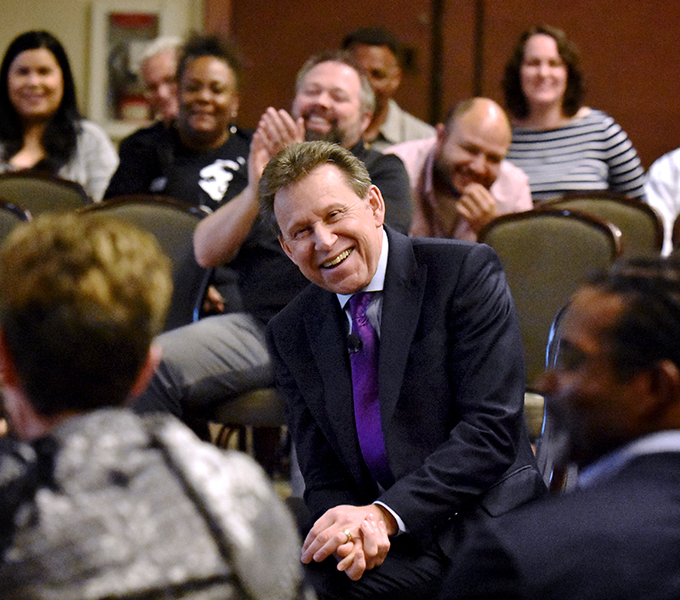University of Redlands Emergency Alert System
Alert Received: . For more information, visit: https://www.redlands.edu/alert/
University of Redlands
- Home
- Och Tamale
- Fall 2020
- Thoughts from the President's Office

One of the challenges of leading an institution such as the University of Redlands is keeping the community informed and united through chaotic times—and there has been no shortage of such times in recent years. Our country is simultaneously facing a historic pandemic, a crisis in the real economy of jobs and wages, and also an increasingly polarized citizenry. Moreover, the last several months have turned our worlds upside down and exposed levels of inequality across race and class in our society.
Embracing diversity, equity, and inclusion is crucial to the University’s health and our educational purpose, and in line with a longstanding commitment expressed for many years in our mission statement. Throughout the last two decades at Redlands, we have undertaken many steps to create a more inclusive campus: In the early 2000s, the University launched the Office of Campus Diversity and Inclusion (originally called the Diversity Office), and Race and Ethnic Studies became an academic major. In 2015, the Open Forum on Diversity and Race Relations led to the formation of the University-wide Council on Inclusiveness and Community or UCIC, which is made up of students, faculty, staff, and administrators. In 2018, we brought in diversity consultant Dr. Jesús Treviño to identify strengths and challenges in campus inclusiveness. And Senior Diversity and Inclusion Officer Christopher Jones, J.D. arrived at the U of R in February and joined my Cabinet in July.
Right now, however, we are living in a moment of heightened awareness of how far we still need to go. Recent national events surely have impressed upon you—as they have upon me and the rest of University leadership—just how urgent it is to continue to work toward a blueprint for diversity, equity, and inclusion on our campuses. And that is why we need to harness the purpose and power of our community.
The force of education is still vital, even as we are all teaching, learning, and working remotely. That force is integrated from the plurality of life experiences, ideas, and values we each bring. By making institutional changes that recognize the value of diversity, equity, and inclusion, the University will be better positioned to use constructive disagreement as a part of intellectual inquiry, problem-solving, and knowledge creation. The purpose of our inquiry is to realize a welcoming and just community at Redlands, which then impacts the society in which we engage.
Some of the University’s most critical recent steps are highlighted in this issue (see pages 14–17). These include engaging a national survey to gain a more accurate sense of the climate for diversity and inclusion on our campuses; revising the University’s anti-discrimination and equity policy to include language that clearly outlines the procedures for making a report and the process to investigate complaints; and tapping into collective university creativity and wisdom by creating the “Inclusive Community and Justice Fund,” which is now supporting seven projects from across the University. Our most recent milestone was holding the University’s first-ever Diversity Town Hall on Sept. 28, hosted by Jones and officially launching the University’s diversity strategic planning process.
I’d like to draw inspiration from and pay tribute to an extraordinary woman, Supreme Court Justice Ruth Bader Ginsburg, who worked toward righting the many inequities she saw throughout the legal system. She said, “Real change, enduring change, happens one step at a time.” This quote is meaningful to me because it implies how we each can contribute to the good we want to see in this world. I imagine her thinking those words of encouragement each time she ascended the 44 steps to the Supreme Court and saw the entablature inscribed above with “Equal Justice Under Law.”
We, too, can collectively make this moment in history an opportunity not only to say what we believe but to demonstrate what we will do about it, taking a journey of infinite steps to make the community and our country ever better. We can model our values in the classroom; we can embrace them in our residences; we can realize them in our teams, cohorts, ensembles, and gatherings (virtual or in-person). And, of course, we can vote.
Democracy derives its entire raison d’ être from pluralism—E pluribus unum or “Out of many, one.” An act of Congress in 1782 approved the inclusion of this phrase on the seal of the United States, and it expresses the power of bringing together not only many states, but many points of view. I am mindful of the exhortation of our recently deceased U.S. Representative John Lewis about elections, the linchpin of democracy, as he said, “The vote is precious. It is almost sacred. It’s the most powerful non-violent tool we have in a democratic society, and we’ve got to use it.”
We all have a hand in directing our nation’s future as we approach the next election. Remember how fortunate we are to live in a country in which we can each vote our conscience, whatever it may be. By voting with our minds and hearts, we do what it takes to make our democracy ever stronger … infinite steps.
Forever yours,
Ralph W. Kuncl, PhD MD
President
University of Redlands